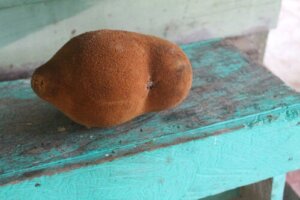Copoazú: What Is It and What Are Its Benefits?


Written and verified by the nutritionist Maria Patricia Pinero Corredor
The copoazú, cupuacu, or Amazonian white cocoa is a tropical fruit. Its scientific name is Theobroma grandiflorum. It’s found in the rainforests of the Colombian Amazon, Peru, and Brazil.
It’s a drupaceous berry, which means that it contains between 20 and 50 seeds covered by pulp, but distributed throughout the fruit. Typically, it’s 12 to 15 centimeters long. Meanwhile, it has a smooth texture and weighs more than a kilo and a half.
This exotic fruit has many benefits for human consumption. We’ll tell you what they are in this article!
The unique characteristics of the copoazú fruit
The copoazú plant is a tree from the Sterculiaceae family, which grows in humid soils and can reach up to 18 meters in height. The seeds are wrapped in a thick pulp that has a very pleasant aroma.
The inside of the berry is a creamy pulp similar to cocoa. In fact, it’s usually known as white cocoa because of the similar taste it has to this other fruit.
The seed has 17.24 grams of protein, 57.22 grams of fat, 5.7 grams of fiber, and 20.7 grams of carbohydrates. It contains a decent amount of unsaturated fatty acids omega 9, omega 3, and a little less omega 6. In fact, it’s estimated that 40.9% is made up of oleic acid.

You’ll definitely like this article: 8 Healthy Foods that are Trending in 2021
The health benefits of copoazú
Overall, this fruit has numerous benefits that we’ll explain below.
1. Copoazú is a powerful antioxidant
Research on the antioxidant activity of the copoazú pulp determined that this fruit contains a high antioxidant potential.
In fact, thanks to the presence of anthocyanins and flavonoids, such as quercetin and kaempferol, it has been linked to a reduced risk of chronic diseases.
Other antioxidant phytochemicals that can be found in the pulp are catechin, epicatechin, tegrandin, and chocolate alkaloids such as theobromine and theophylline. Finally, tocopherols or vitamin E and carotenoids also enhance its antioxidant capacity,
2. It’s a type of fat that’s suitable for industrial use
Copoazu fat, unlike cocoa butter, is less rancid. This is because it contains very few free fatty acids that are easily oxidized. However, the remaining fatty acids are similar to those of cocoa butter.
As indicated by the Ibero-American Network, copoazu oil contains 50.43% saturated fatty acids and 40.82% unsaturated fatty acids. Meanwhile, cocoa butter contains 69.3% saturated fatty acids and 30.7% unsaturated fatty acids. A higher number of unsaturated predisposes it to oxidative rancidity.
Cupuacu contains 36.30% oleic, 29.27% stearic acid, 11.22% arachidic and 7.26% palmitic. Linoleic acid, known as omega 6, is found in low amounts.
Therefore, its pulp can be used in the food industry, such as nectars, sweets, jams, juices, and yogurt. The seed can also be used to make beverages. In fact, the magazine Información Tecnológica explains that copoazú oil is classified as a non-drying oil.
We think you’ll like this article: Healthy Snacks for Any Time of the Day
3. Copoazú butter is a raw material for the cosmetics industry
Cupuacu can also be used to obtain a finished, industrialized product known as Copoazú butter.
To extract it, the fruit must be cold-pressed until a soft, nutritious, emollient, and moisturizing paste is obtained.
This butter is capable of maintaining healthy skin, thanks to its fatty acids that stabilize emulsions. Palmitic, oleic, and stearic fatty acids, as well as sterols and polyphenols, also help with this.
In fact, the Regional Agricultural Program of Colombia reiterates that the types of fats found in this fruit are both polyunsaturated and saturated. They have a melting point that softens when applied to the skin, allowing rapid absorption. This makes them suitable for making cosmetics.
4. It’s an ally for hair health
The copoazú fruit contains an acceptable amount of essential fatty acids. The body can’t synthesize them, so they must be obtained through our diet.
These fatty acids can also help our hair. By doing so, they prevent it from dehydrating, breaking, or drying. In addition, this provides nutrition to the hair.
5. Copoazú contributes to the reduction of bad cholesterol
Next, its high content of monounsaturated fatty acids and a moderate proportion of essential fatty acids help prevent cardiovascular diseases. This is because it lowers triglycerides, reduces LDL cholesterol, and increases HDL cholesterol.
LDL is often known as bad cholesterol. It’s a low-density lipoprotein that, in large amounts, causes clogged arteries.
6. This fruit provides anti-inflammatory properties
A review indicates that the presence of antioxidants in the pulp and seeds of copoazú benefits health. In fact, they prevent oxidative stress and function as anti-inflammatory agents.
7. You can make chocolate-like products with Copoazú fruit
Finally, the Colombian Agricultural Program also highlights that chocolate-like products can be made using its protein-rich seeds. These must be pulped, fermented, dried, roasted, pressed and then ground.
This product is known as copulate.
Copoazú: Uses in the kitchen
This tasty fruit can have several applications in the manufacture of food and homemade recipes. You can use the pulp to make jellies, nectars, ice cream, yogurt, liqueurs, jellies, wines, and even sweets.
Plus, the copoazú seeds can also be used to make white chocolate and other confectionery products. Another way to use it is as a cooking fat, similar to butter.
Let’s take a look at a tasty recipe!
Copoazú Mousse Recipe
Overall, to prepare this recipe you need the following ingredients:
- 4 egg whites
- 1/4 kilo of sugar
- 4 cherries
- 1/2 kilo of cupuacu pulp
- 400 grams of heavy cream
- 50 grams of ground chocolate
- 20 grams of hydrated gelatin

Next, follow these steps to make it:
- Blend the cupuacu pulp for a few minutes.
- Meanwhile, in another pot, add the gelatin and 50 grams of sugar. Cook the gelatine until it boils. Then let it cool and set it aside in a bowl.
- Make a syrup with the water and sugar, stirring constantly.
- In another bowl, beat the egg whites well.
- When the syrup is ready, remove it from the heat and add the beaten egg whites, stirring constantly until the right consistency is obtained.
- Then, in a separate bowl, add the pulp of the blended copoazú and the syrup. Mix and keep in glasses in the refrigerator for 2 hours.
- When serving, top with whipped cream and add grated chocolate and a cherry.
- This makes four servings.
Does copoazú fruit have any contraindications?
Finally, we must remember that excessive consumption of copoazú is not recommended to prevent weight problems. This is due to its high caloric content. It provides 315 calories per 100 grams, since its fat content is very high.
In pregnant and lactating women, it’s advisable to consult a doctor about the amount to be consumed. In the case of children, they can eat it 1 to 2 times a week.
All cited sources were thoroughly reviewed by our team to ensure their quality, reliability, currency, and validity. The bibliography of this article was considered reliable and of academic or scientific accuracy.
- CORPOINCA. Fondo Amazónico. Programa Regional Agrícola. El Cultivo de Copoazú (Theobroma glandiflora). Florencia. 1996. Disponible en: http://bibliotecadigital.agronet.gov.co/bitstream/11348/4907/1/Cultivo%20de%20copoazu.pdf.
- Alviárez G.a W. Murillo A.a E. Murillo P.a B. A. Rojanob J. J. Méndez A. Caracterización y extracción lipídica de las semillas del cacao amazónico (Theobroma grandiflorum). Revista Ciencia en Desarrollo, 2016, Vol. 7 No. 1, pp. 103-109.
- G., E. Alviárez, W. Murillo A., E. Murillo P., B. A. Rojano, and J. J. Méndez A. “Caracterización Y Extracción Lipídica De Las Semillas Del Cacao Amazónico [Theobroma Grandiflorum].”Ciencia En Desarrollo. 2016, 7, no. 1.
- Lafont, Jennifer J, Páez, nuel S, & Portacio, Alfonso A. (2011). Extracción y Caracterización Fisicoquímica del Aceite de la Semilla (Almendra) del Marañón (Anacardium occidentale L). Información tecnológica, 22(1), 51-58. https://dx.doi.org/10.4067/S0718-07642011000100007
- Panche AN, Diwan AD, Chandra SR. Flavonoids: an overview. J Nutr Sci. 2016;5:e47. doi: 10.1017/jns.2016.41. PMID: 28620474; PMCID: PMC5465813.
- El Cultivo de Copoazú. Copoinca. Florencia. 1996. Disponible en : http://bibliotecadigital.agronet.gov.co/bitstream/11348/4907/1/Cultivo%20de%20copoazu.pdf
This text is provided for informational purposes only and does not replace consultation with a professional. If in doubt, consult your specialist.








